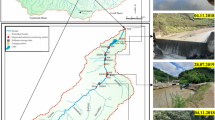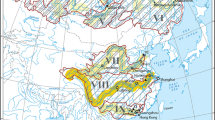Abstract
Fluvial suspended sediment has multi-fold environmental implications and the study of the variation in suspended sediment load (SSL) of rivers is important both in environmental earth sciences and in river environmental management. Based on data collected for the upper Yellow River of China in the past 50–60 years, the purpose of this study is to elucidate the impact of human activity and climate change on SSL, thereby to provide some knowledge for the improvement of the drainage basin management. The results show that the SSL of the upper Yellow River exhibited a remarkable decreasing trend. A number of reservoirs trapped a considerable amount of sediment, resulting in a reduction in SSL at Toudaoguai station, the most downstream station of the upper Yellow River. The analyses based on Mann–Kendall’U and double-mass plot indicate some turning points, which were caused by the Liujiaxia and Longyangxia Reservoirs, two major reservoirs on the upper Yellow River. The implementation of soil and water conservation measures reduced the runoff coefficient, and therefore, the intensity of soil erosion. The climate change also played a role in reducing sediment yield. The increase in air temperature enhanced the evapo-transpiration and reduced the runoff, by which the SSL decreased. The decreased frequency of sand-dust storms reduced the amount of wind-blown, sand and dust to the river reaches located in desert, also reducing the SSL. Seven influencing variables are selected to describe the changing human activity and climate. As some of the influencing variables are strongly inter-correlated, the principle component regression was used to establish the relationship between SSL and the influencing variables. The squared multiple correlation coefficient is R 2 = 0.823. Some further research is suggested with the minerals and pollutants related with the SSL.








Similar content being viewed by others
References
Brandt SA (2000) Classification of geomorphological effects downstream of dams. Catena 40(4):375–401
Brune GM (1953) Trap efficiency of reservoirs. Trans Am Geophys Union 34(3):407–418
Chapman D (1992) Water quality assessments: a guide to the use of biota sediments and water in environmental monitoring. Chapman and Hall, London, pp 78–81
Chien N, Wang KX, Yan LD, Fu RS (1980) The source of coarse sediment in the middle reaches of the Yellow River and its effect on the siltation of the lower Yellow River. In: Chinese Society of Hydraulic Engineering (ed) Proceedings of the 1st International Symposium on River Sedimentation, Beijing, pp 53–62
Demaree GR, Nicolis C (1990) Onset of Sahelian drought viewed as fluctuation-induced transition. Q J Royal Meteorol Soc 116:221–238
Dibike YB, Coulibaly P (2005) Hydrologic impact of climate change in the Saguenay watershed: comparison of downscaling methods and hydrologic model. J Hydrol 307:145–163
Drogue G, Pfister L, Leviandier T (2004) Simulating the spatio-temporal variability of stream flow response to climate change scenarios in a mesoscale basin. J Hydrol 293:255–269
Duan SW, Zhang S, Huang HY (2000) Transport of dissolved inorganic nitrogen from the major rivers to estuaries in China. Nutr Cycl Agroecosyst 57(1):13–22
Graf WL (1999) Dam nation: a geographic census of American dams and their large-scale hydrologic impacts. Water Resour Res 35(4):1305–1311
Hong S, Zhang H, Lian Y, Li H, Zhang XC, Zhang XH, Xue Y (2002) Yellow River basin comprehensive assessment. Draft report of the IWMI–Yellow River Conservancy Commission Project entitled Yellow River comprehensive assessment, December 2002 (in Chinese)
Hou SZ, Wang P, Chang WH (2007) Evaluation on the volume of scour and fill of Inner Mongolia section of the Yellow River. Yellow River 29(4):21–22 (in Chinese)
Jolliffe IT (1982) A note on the use of principal components in regression. J Royal Stat Soc Ser C (Appl Stat) 31(3):300–303
Kamga FM (2001) Impact of greenhouse gas induced climate change on the runoff of the upper Benue River (Cameroon). J Hydrol 252:145–156
Kramer R (1998) Chemometric techniques for quantitative analysis. Marcel-Dekker, New York (ISBN 0-8247-0198-4)
Liquete C, Canals M, Ludwig W, Arnau P (2009) Sediment discharge of the rivers of Catalonia, NE Spain, and the influence of human impacts. J Hydrol 366:76–88
Liu C, Sui J, Wang ZY (2008) Changes in runoff and sediment yield along the Yellow River during the period from 1950 to 2006. J Environ Inform 12(2):129–139
Liu XY, Hou SZ, Chang WH (2009) Cause of main channel shrinkage occurred to the Inner-Mongolia reaches of Yellow River. J Hydraul Eng 40(9):1048–1054 (in Chinese)
Liu LL, Liu ZF, Ren XY, Fischer T, Xu Y (2011) Hydrological impacts of climate change in the Yellow River basin for the 21st century using hydrological model and statistical downscaling model. Quat Int. doi:10.1016/j.quaint.2010.12.001
Lu XX, Siew RY (2006) Water discharge and sediment flux changes over the past decades in the lower Mekong River: possible impacts of the Chinese dams. Hydrol Earth Syst Sci 10:181–195
Lu E, Takle E, Manoj J (2010) The relationship between climatic and hydrological changes in the upper Mississippi River basin: a SWAT and multi-GCM study. J Hydrometeorol 11:437–451
Miao CY, Ni JR, Borthwick AGL (2010) Recent changes in the water discharge and sediment load in the Yellow River basin, China. Prog Phys Geogr 34:541–561
Miao C, Ni JR, Borthwick AGL, Yang L (2011) A preliminary estimate of human and natural contributions to the changes in water discharge and sediment loads in the Yellow River. Glob Planet Change. doi:10.1016/j.gloplacha.2011.01.008
Milliman JD, Meade RH (1983) World-wide delivery of river sediment to the oceans. J Geol 91:1–21
Milliman JD, Syvitski JPM (1992) Geomorphic/tectonic control of sediment discharge to the ocean: the importance of small mountainous rivers. J Geol 100:525–544
Moraes JM, Pellegrino HQ, Ballester MV, Martinelli LA, Victoria R, Krusche AV (1998) Trends in hydrological parameters of a southern Brazilian watershed and its relation to human induced changes. Water Resour Manag 12:295–311
Ran LS, Wang SJ, Fan XL (2010) Channel change at Toudaoguai station and its responses to the operation of upstream reservoirs in the upper Yellow River. J Geogr Sci 20(2):231–247 (in Chinese)
Samuels R, Rimmer A, Hartmann A, Alpert S (2010) Climate change impacts on Jordan River flow: downscaling application from a regional climate model. J Hydrometeorol 11:860–879
Shen GQ, Zhang YF, Hou SZ, Shang HX (2007) Impact of water and sediment regulation by reservoirs in the upper Yellow River on Inner-Mongolia reaches. J Sediment Res 1:67–75 (in Chinese)
Sun JH, Wang GL, Zhang G et al (2007) Distribution of organochlorine pesticides in surface sediments from the middle and lower reaches of the Yellow River. Environ Sci 28(6):1332–1337 (in Chinese)
Syvitski JPM, Vörösmarty CJ, Kettner AJ, Green P (2005) Impact of humans on the flux of terrestrial sediment to the global coastal ocean. Science 308:376–380
Ta WQ, Yang GS, Qu JJ et al (2003) The effect of the coarse Aeolian sand on siltation of the Inner Mongolian reach of the Yellow River. Environ Geol 43:493–502
Ta WQ, Xiao HL, Dong ZB (2008) Long term morphodynamic changes of a desert reach of the Yellow River following upstream large reservoirs’ operation. Geomorphology 97:49–259
Vörösmarty CJ, Meybeck M, Fekete B, Sharma K, Green P, Syvitski JPM (2003) Anthropogenic sediment retention: major global impact from registered river impoundments. Glob Planet Change 39(1–2):169–190
Walling DE, Fang D (2003) Recent trends in the SSLs of the world’s rivers. Glob Planet Change 39(1–2):111–126
Wang G, Fan Z (eds) (2002a) A study of water and sediment changes in the Yellow River, vol 1. Publishing House of Yellow River Water Conservancy (in Chinese), Zhengzhou
Wang G, Fan Z (eds) (2002b) A study of water and sediment changes in the Yellow River, vol 2. Publishing House of Yellow River Water Conservancy (in Chinese), Zhengzhou
Wang HJ, Yang ZS, Saito Y et al (2007) Stepwise decreases of the Huang He (Yellow River) sediment load (1950–2005): impacts of climate change and human activities. Glob Planet Change 57(3–4):331–354
Wang SJ, Fan XL, Zhao XK (2010) Spatial and temporal variations of suspended sediment capacity by erosion or deposition in the Ningmeng reach of the Yellow River and its influencing factors. Geogr Res 29(10):1880–1887 (in Chinese)
Wilcher LS (1992) EPA’s commitment to sound science and water quality standards. In: Proceedings of the 3rd national conference on water quality standards for the 21st Century. Las Vegas, p 7213
Williams GP, Wolman MG (1984) Downstream effects of dams on alluvial rivers. Geological Survey Professional Paper 1286. USGS, Washington, p 61
Xi JZ (1999) Water resources of the Yellow River. Publishing House for Water Conservancy of the Yellow River (in Chinese), Zhengzhou
Xin LJ, Li XB, Tan MH (2012) Temporal and regional variations of China’s fertilizer consumption by crops during 1998–2008. J Geogr Sci 22(4):643–652
Xu JX (1998) A study of physico-geographical factors for formation of hyperconcentrated flows in the Loess Plateau of China. Geomorphology 24:245–255
Xu JX (2012) The geomorphological processes of the Yellow River drainage basin. Science Press, Beijing (in Chinese)
Xu JX, Cheng DS (2002) Relation between the erosion and sedimentation zones in the Yellow River, China. Geomorphology 48(4):365–382
Xu JX, Yan YX (2010) Effect of reservoir construction on SSL in a large river system: thresholds and complex response. Earth Surf Proc Land 35:1666–1673
Xu ZX, Takeuchi K, Ishidaira H (2002) Long-term trends of annual temperature and precipitation time series in Japan. J Hydrosci Hydraul Eng 20(2):11–26
Xu JX, Yang JS, Yan YX (2006) Erosion and sediment yield as influenced by coupled eolian and fluvial processes: the Yellow River, China. Geomorphology 73(1):1–15
Xu ZX, Zhao FF, Li JY (2009) Response of streamflow to climate change in the headwater catchment of the Yellow River basin. Quat Int 208:62–75
Yang QY, Yuan BY (eds) (1991) Natural environment and its changes. Science Press (in Chinese), Beijing
Yang GS, Shi PJ, Liu YX (1987) Estimate of wind blown sand into the upper Yellow River. Chin Sci Bull 32(13):1017–1021 (in Chinese)
Yang GS, Ta WQ, Liu YX, Jing K, Zhang O, Lu R, Hu LF, Tao Y (2003) Contribution of sand sources to the silting of riverbed in Inner Mongolia section of Huang He River. J Desert Res 23(2):152–159 (in Chinese)
Yang ST, Cheng HG, Bu QS et al (2006) Estimation of soil erosion and its application in assessment of the absorbed nitrogen and phosphorus load in China. Acta Scientiae Circum stantiae 26(3):366–374 (in Chinese)
Ye QC (ed) (1994) Researches on environmental changes of the Yellow River basin and laws of water and sediment transportation. Shandong Science and Technology Press, Jinan, pp 1–220 (in Chinese)
Yellow River Water Conservancy Commission (2000–2008) Bulletin of sediment of the Yellow River
Yonas BD, Paulin C (2005) Hydrologic impact of climate change in the Saguenay watershed: comparison of downscaling methods and hydrologic models. J Hydrol 307:145–163
Zhao WL, Cheng XW, Hou SZ (1999) Analysis of scouring and sedimentation in the channel from Ningxia to Inner Mongolia in the upper Yellow River. Yellow River 6:11–14 (in Chinese)
Zhao YA, Dai MY, Xiong GS, Lu GX, Zeng ML (2008) A study on key techniques for flow and sediment regulation by reservoirs on the upper Yellow River and on the possible adjustment of operational mode of the Longyangxia and Liujiaxia Reservoirs. Research report of the Yellow River Institute for Water Resources and Hydraulic Engineering (in Chinese)
Zheng HX, Zhang L, Zhu RR, Liu CM, Sato Y, Fukushima Y (2009) Responses of streamflow to climate and land surface change in the headwaters of the Yellow River basin. Water Resour Res 45:W00A19. doi:10.1029/2007wr006665
Acknowledgments
The financial support from the National Major Basic Research Program of China (2011CB403303), Natural Science Foundation of China (41071016) and Chinese Academy of Sciences is gratefully acknowledged. All hydrometrical data are provided by the Yellow River Water Conservancy Commission, and the precipitation and sand-dust storm data by the National Bureau of Meteorology of China. We are grateful to the anonymous reviewers, whose comments and suggestions are valuable for improvement of the manuscript.
Author information
Authors and Affiliations
Corresponding author
Electronic supplementary material
Below is the link to the electronic supplementary material.
Rights and permissions
About this article
Cite this article
Yao, W., Xu, J. Impact of human activity and climate change on suspended sediment load: the upper Yellow River, China. Environ Earth Sci 70, 1389–1403 (2013). https://doi.org/10.1007/s12665-013-2223-4
Received:
Accepted:
Published:
Issue Date:
DOI: https://doi.org/10.1007/s12665-013-2223-4




